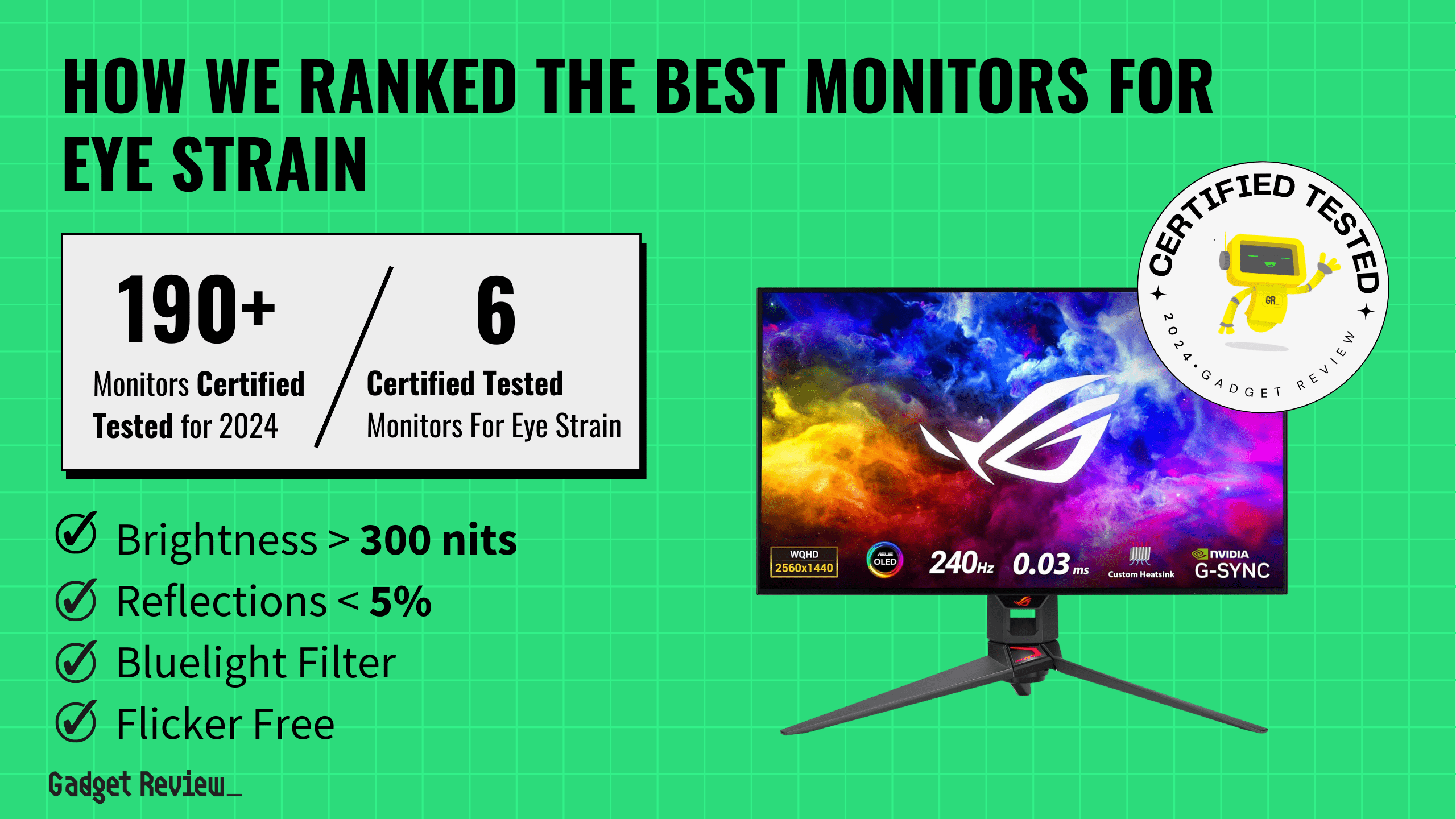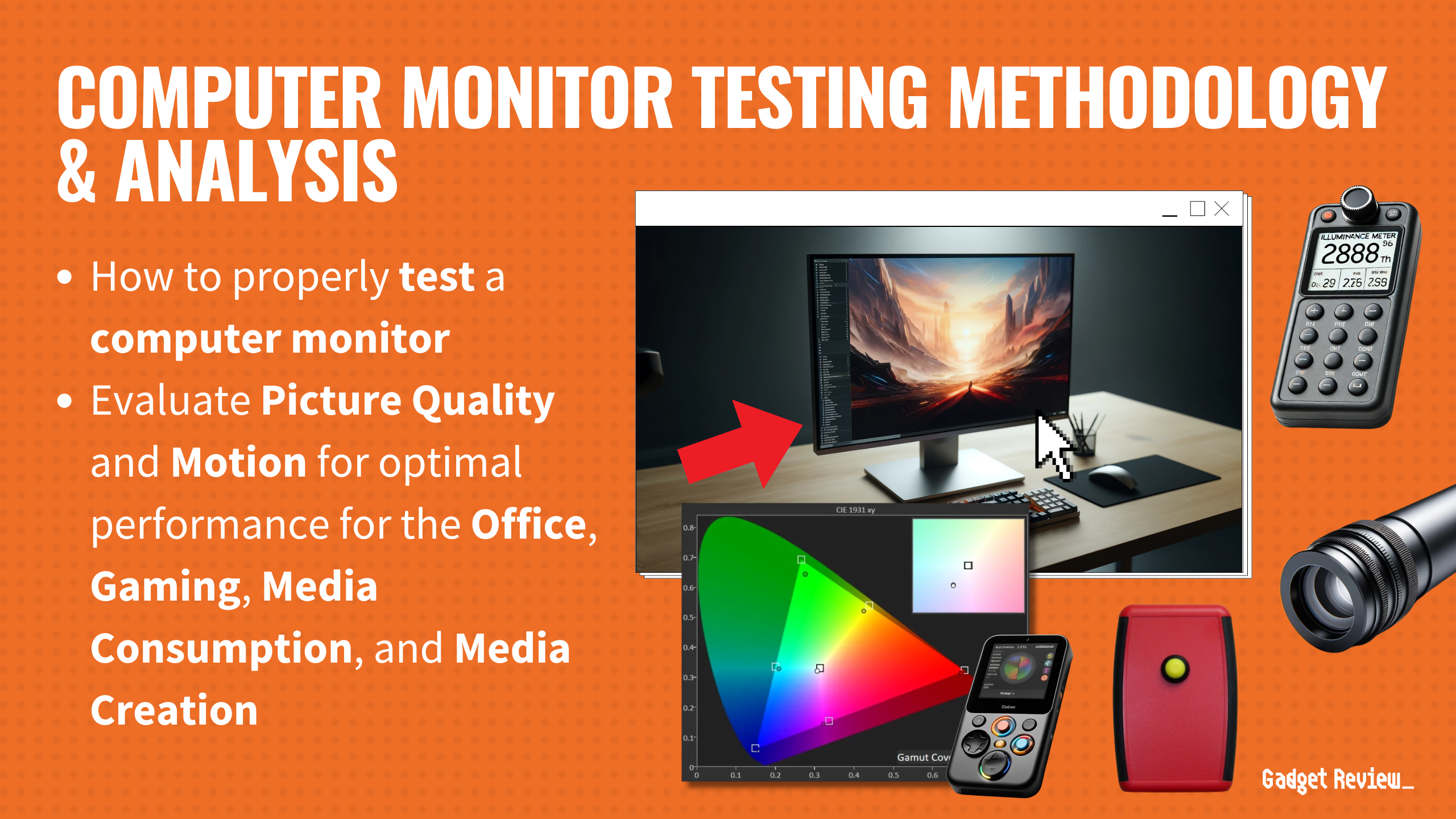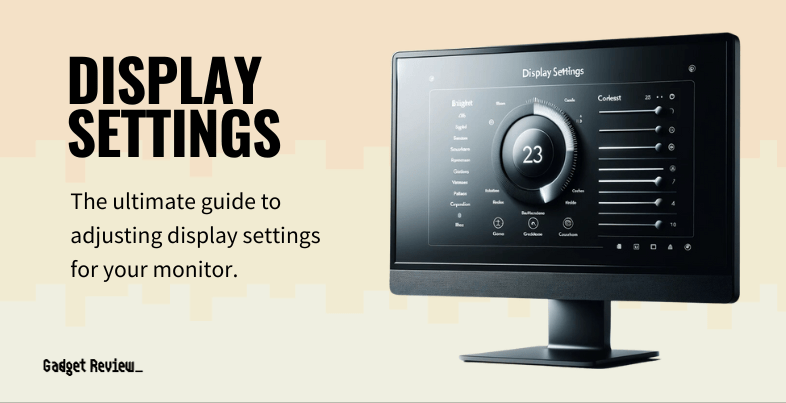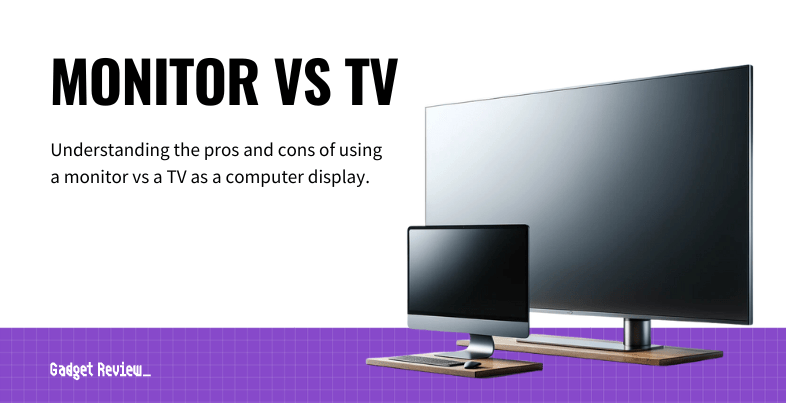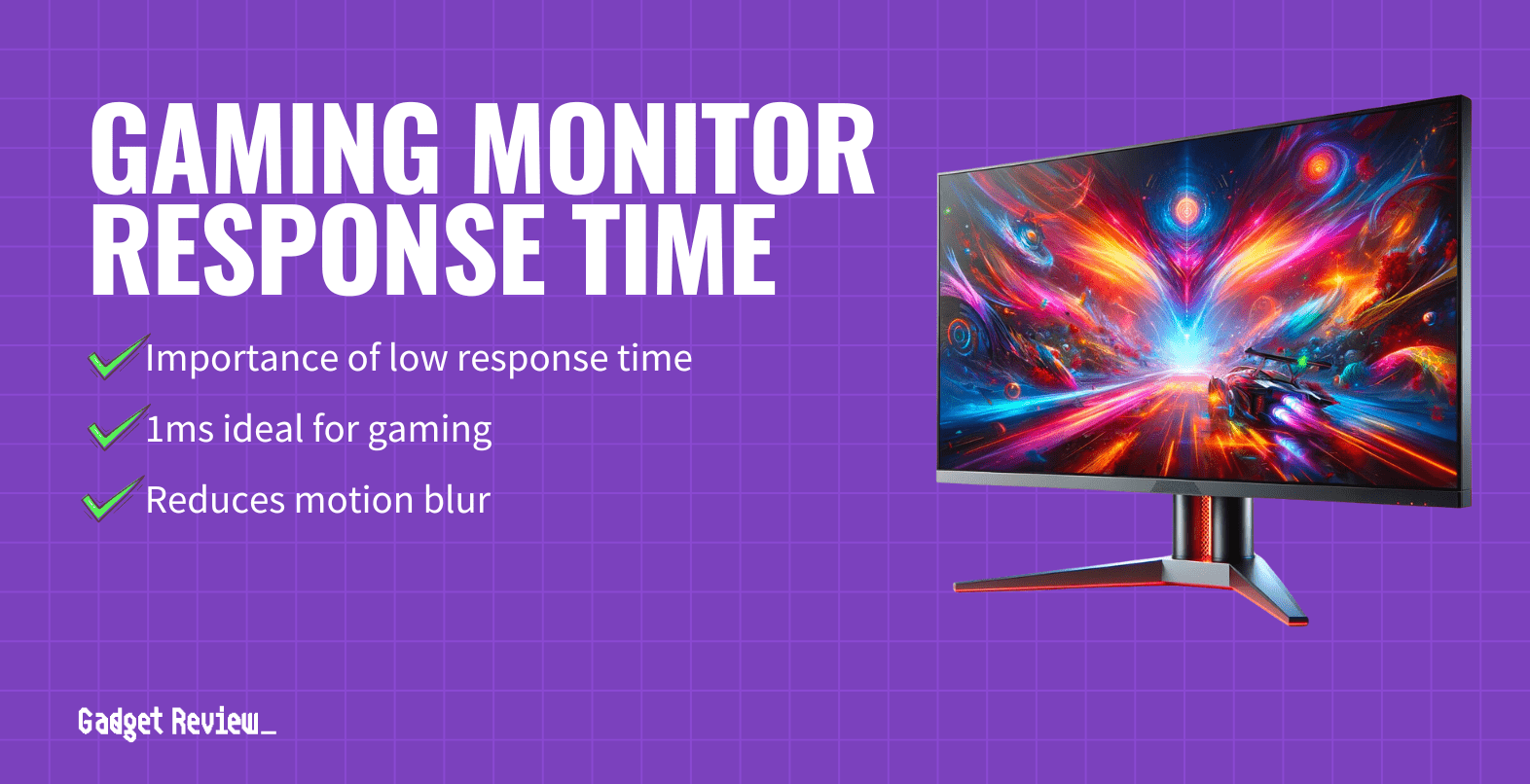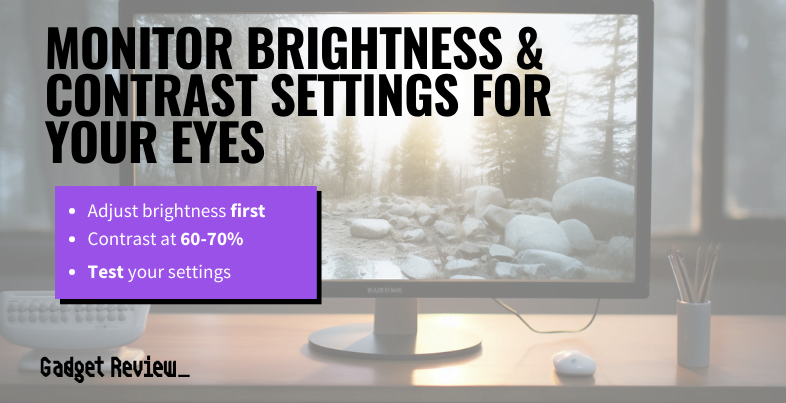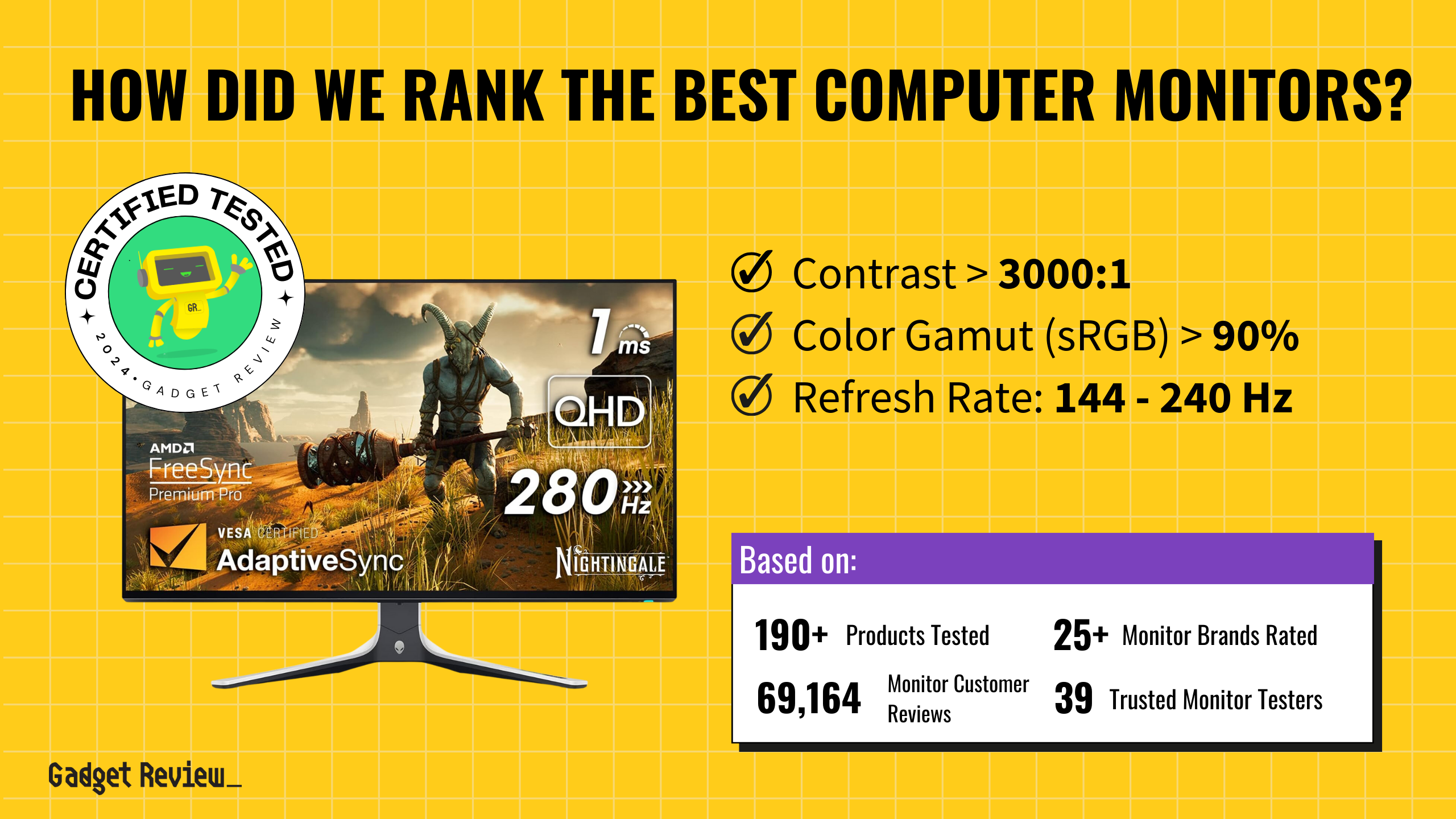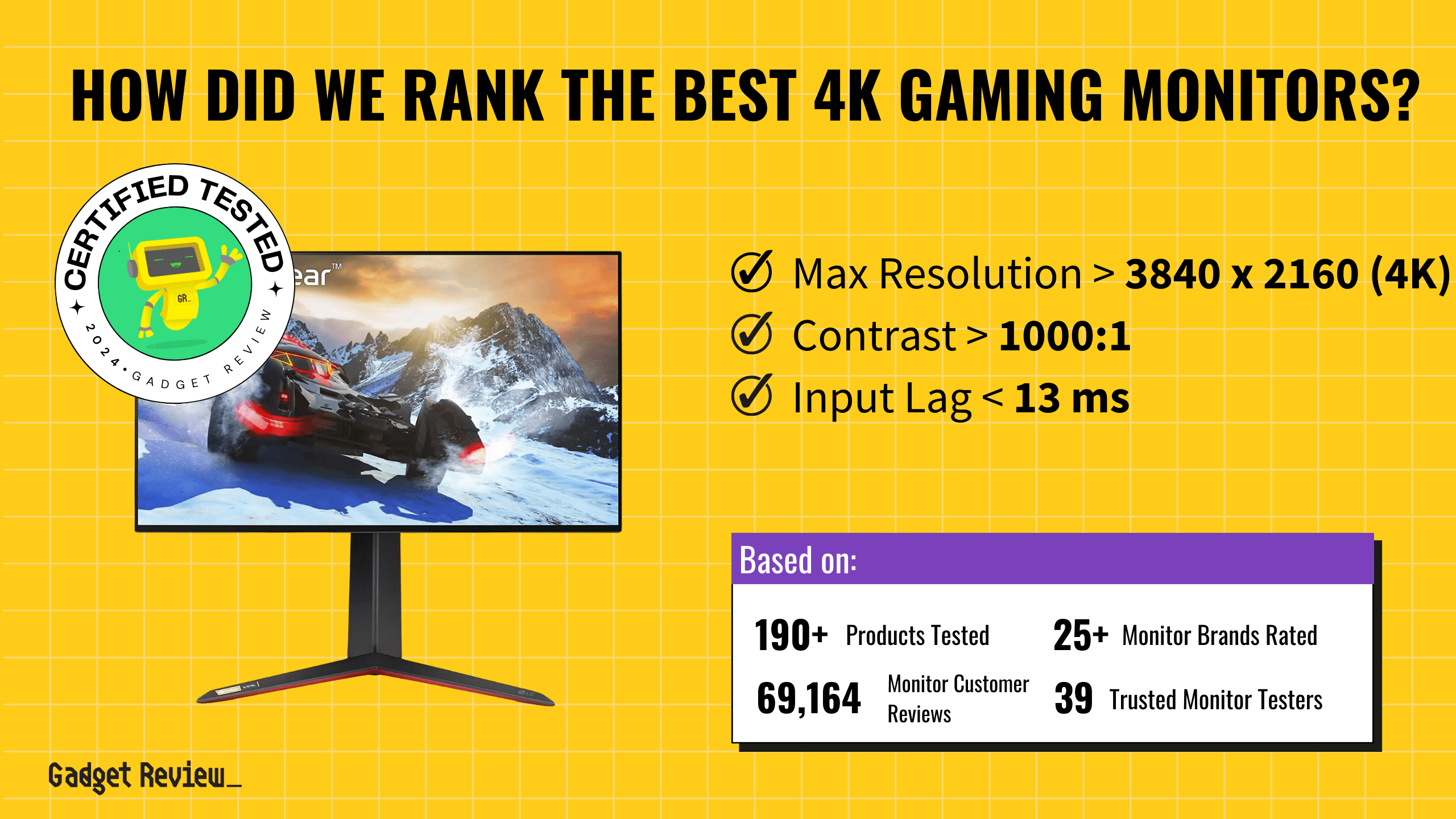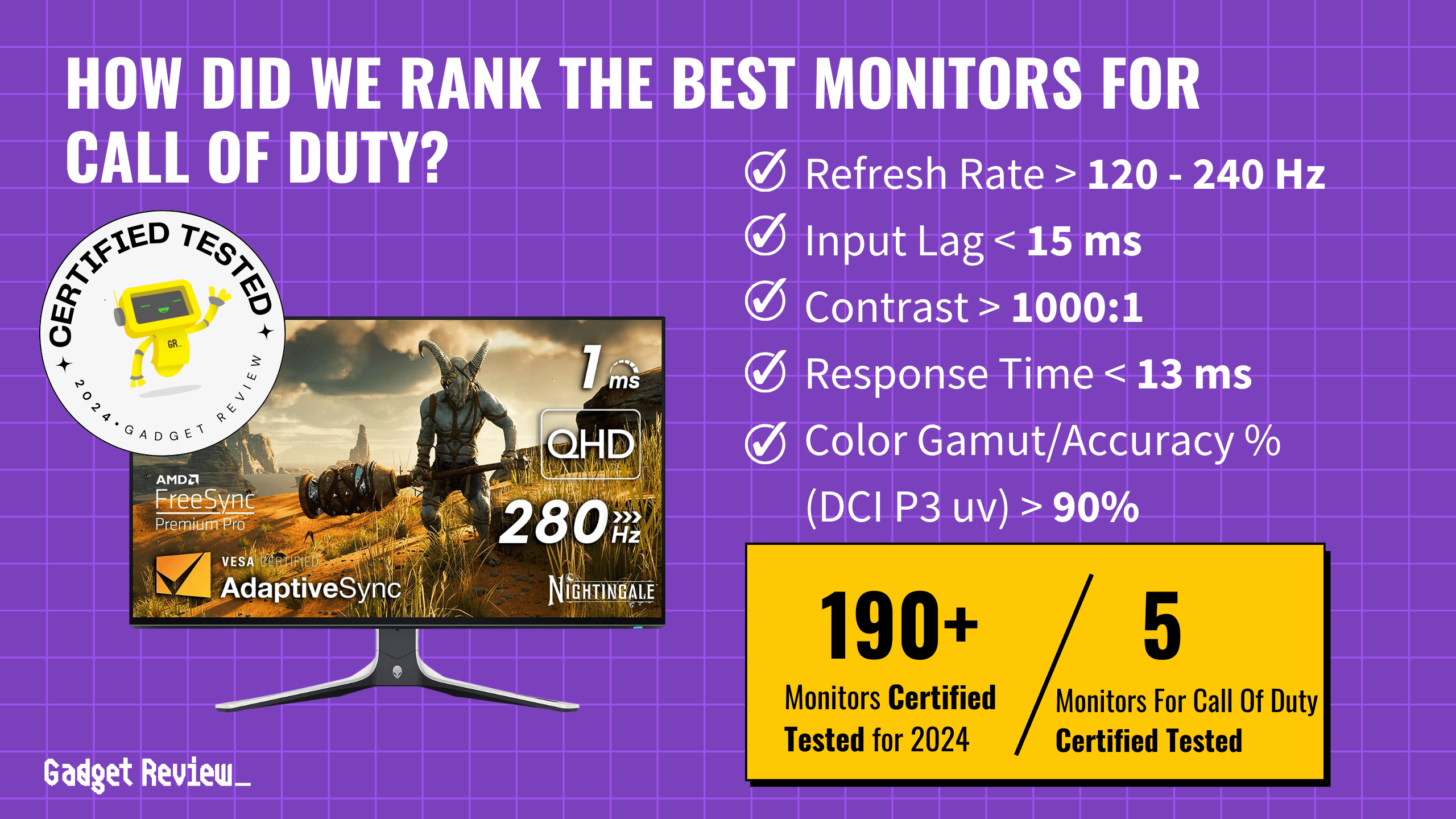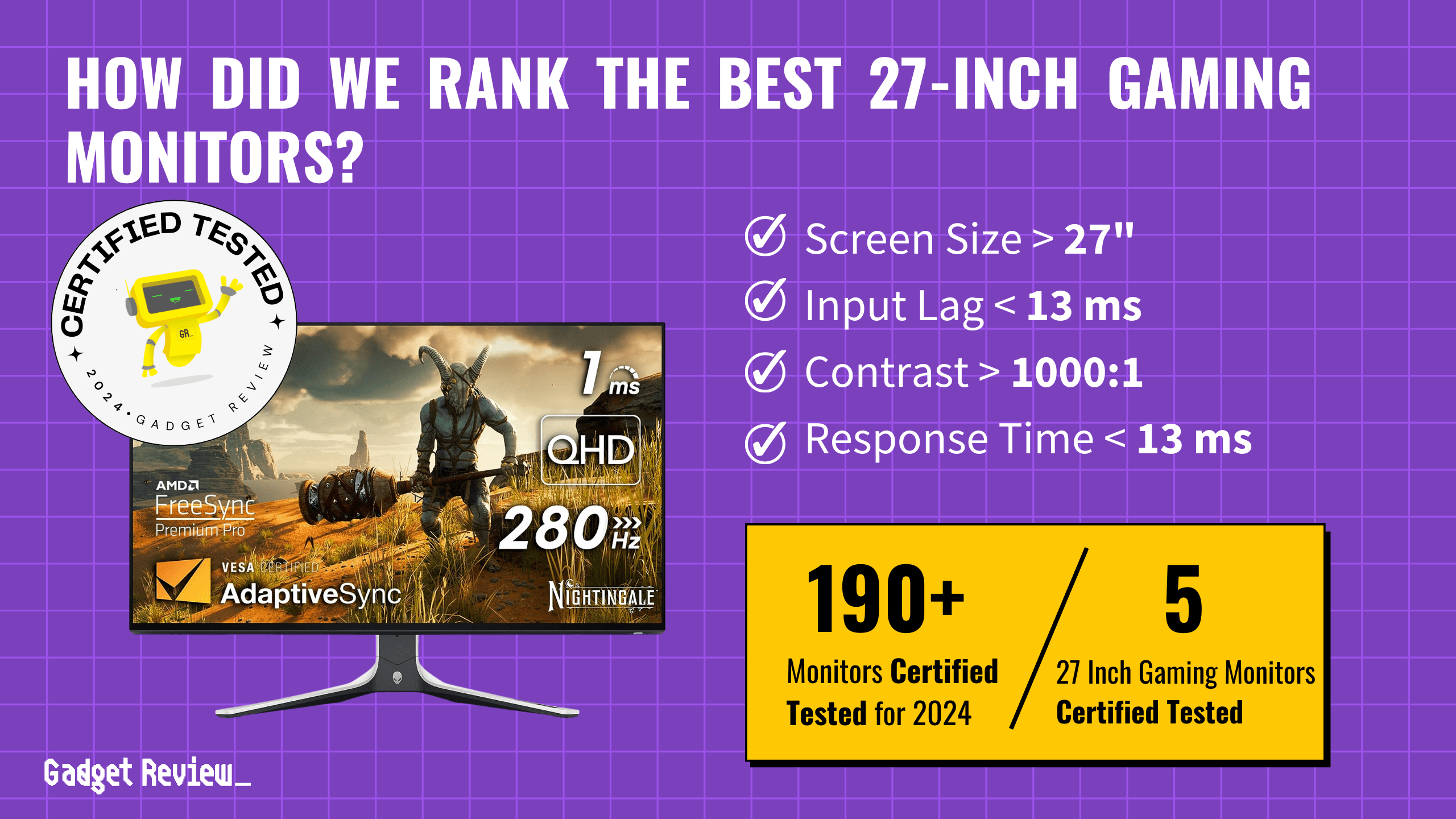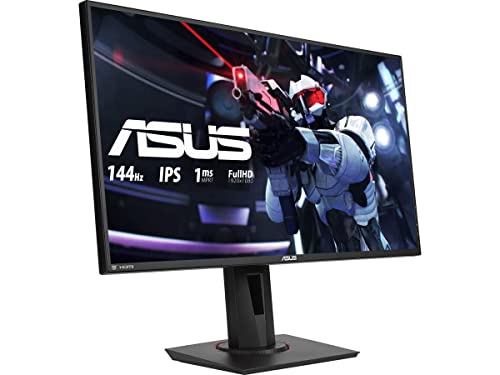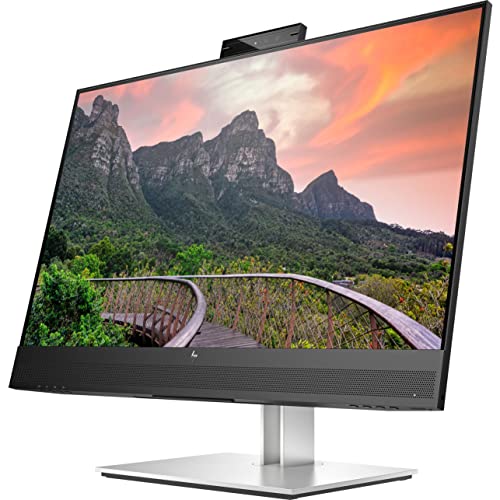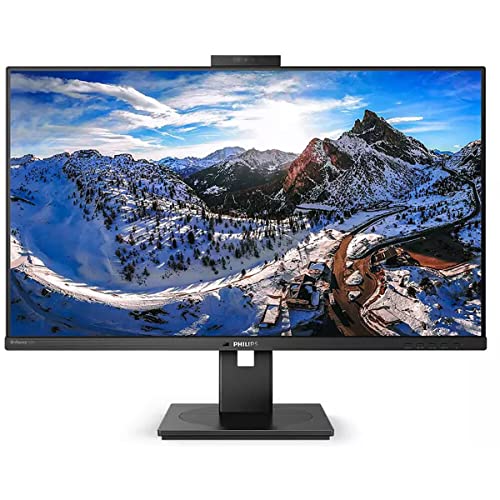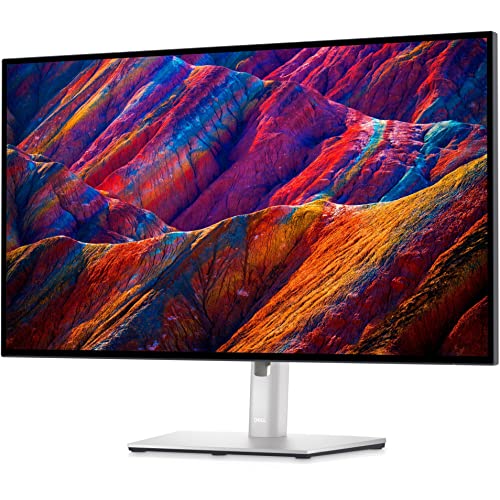When you’re seeking relief from eye strain, choosing a monitor with the right features is crucial. Monitors that offer blue-light filters, flicker-free technology, and adjustable stands significantly reduce eye fatigue. High brightness and excellent contrast ratios are essential to combat various lighting conditions, ensuring comfortable viewing for extended periods.
We analyzed 196 monitors, certifying 6 as the best for minimizing eye strain. Our evaluation covered 319,977 reviews, and 71% of experts failed our trustworthiness test. Our unique approach includes verifying product performance and using our Trust Score to filter out fake reviews. These top monitors excelled in our stringent testing criteria, ensuring optimal eye care. If you already have an excellent computer monitor and aren’t looking to replace it, consider trying the best blue-light blocking glasses to see if they help reduce eye fatigue and improve comfort during prolonged use.
How Did We Rank the Best Monitor for Eye Strain?
Crafting our buying guide for the best monitors for eye strain involved analyzing over 200 websites to gather data from various testing methods and customer reviews. Gadget Review’s true score system distills this information into 2 required test results and 2 must-have specifications. Our expert analysis focused on identifying the main causes of eye strain, helping you choose a monitor that reduces discomfort and enhances visual comfort with confidence.
Our commitment to unbiased reviews is powered by our ‘True Score’ system, targeting low quality and fake reviews. When you shop through our links, you’re backing our mission. Dive deeper to see how.
?️ Minimum Specifications
- Must have flicker-free tech
- Must have a blue light filter
? Test Criteria
- Brightness: Equal to or greater than 300 nits, ensuring a bright and clear display under any lighting conditions.
- Reflections: A reflection percentage of less than 5% of the total light emitted ensures optimal performance across a wide range of lighting environments, enhancing overall viewing pleasure.
Latest Updates
- 04/30/2024: Republished the list to include the best monitors for eye strain based on our True Score system.
Top Monitor for Eye Strain For 2025
Prices accurate at the time of publishing

Best Overall

Runner Up

Best Value

Best Budget

Best Mid-Range

Premium Pick
Asus ROG PG27AQDM
Best For Asus
The Asus ROG PG27AQDM, with its reflectance rate, refresh rate, response time, and eye-care features, offers excellent performance and comfort. Ideal for professionals and gamers, its cost is justified by its visibility and minimal eye strain.
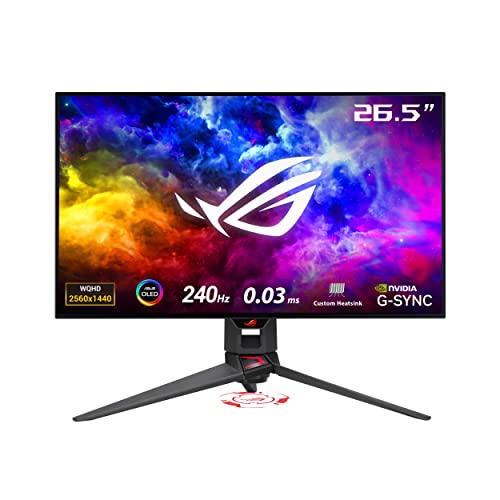
True Score
878910Experts
906kCustomers
Absolutely Fresh
 $741.00
$741.00Read More
Snapshot
Reasons to Buy
- Stellar Picture Quality
- Fast Response Time
- Low Input Lag
- High Refresh Rate and VRR Support
- Wide Viewing Angles
Reasons to Avoid
- No HDMI 2.1 Support
- Low Overall Brightness
Specifications

Aspect Ratio 16:9 
Available Inputs 3.5mm, DisplayPort, HDMI, USB 
Bluelight Filter Yes 
Built-In Speakers Yes 
Built-In Webcam No 
Curved Screen No Display Type LED 
Flicker Free Yes HDMI Inputs 2 HDR Format HDR10 High Dynamic Range (HDR) Yes Max Resolution 2560 x 1440 
Panel Type OLED Refresh Rate 240 Hz 
Response Time 0.03 ms 
Rotating Screen Yes Screen size 26.5″ 
Sync Technology AMD FreeSync, G-Sync All Specs
Test Results
Brightness (nits) 311 Contrast Ratio (as ratio, x:1) 0 Color Gamut/Accuracy % (DCI P3 xy) 95 Color Gamut/Accuracy % (DCI P3 uv) 0 Color Gamut % (Adobe RGB Coverage xy) 90 Color Gamut % (sRGB Coverage xy) 100 All Retailers
- $741.00
Availability
In StockFree Shipping
No - $749.00
Availability
In StockFree Shipping
Yes
Our Verdict
If you are a professional seeking a monitor that excels in productivity tasks without straining your eyes, or if you value a smooth, blur-free viewing experience, then the Asus ROG PG27AQDM is a reliable choice. Despite being the most expensive, it offers a good value for the performance it delivers. The monitor’s reflectance rate is minimal at 2.0%, which means less light is reflected off the screen, enhancing visibility and further reducing eye strain in brightly lit environments.
Compared to the Viewsonic XG2431, the Asus ROG PG27AQDM has a slightly lower brightness (311.2 nits vs. 354.195 nits), but it compensates for this with a lower input lag of 13.9 ms. This makes it great for dynamic scenes while watching indoors with limited direct sunlight.
Its impressive refresh rate of 240.0 Hz and response time of 2.13 ms ensure a smooth viewing experience. This is beneficial for fast-paced applications, where rapid screen updates can make a significant difference. The Asus ROG PG27AQDM is equipped with a blue light filter and flicker-free technology, both of which are essential for reducing eye strain during prolonged use. The OLED panel type offers true blacks and a high contrast ratio, enhancing the image quality and making the visuals less harsh on the eyes.
The Asus ROG PG27AQDM provides excellent value for its premium tag. Its ability to handle reflections, refresh rate, response time, and eye-care technologies make it a top choice for users who prioritize both performance and eye comfort. The price and lower brightness compromise here, but whether you’re a professional, a gamer, or a general user, this monitor delivers a remarkable and comfortable viewing experience.
Read Less

Best Overall

Runner Up

Best Value

Best Budget

Best Mid-Range

Premium Pick
HP OMEN 27QS
Best For Mac Mini
The HP OMEN 27QS has low input lag, high brightness, and a 240Hz refresh rate, making it a great budget pick for gaming and bright environments. Its reflectance rate and DCI-P3 coverage ensure good visibility and vibrant colors.
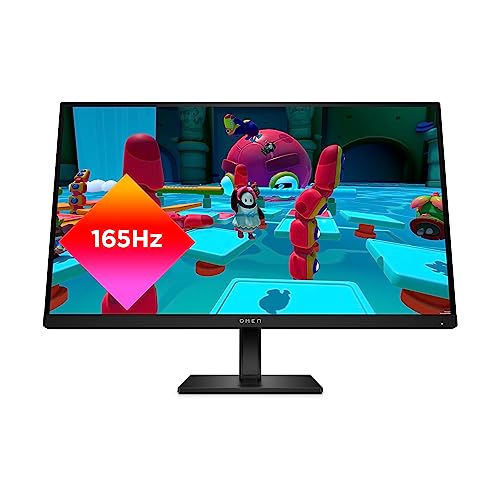
True Score
85834Experts
911kCustomers
Absolutely Fresh
 SAVE $120$339.99$219.99
SAVE $120$339.99$219.99Read More
Snapshot
Reasons to Buy
- Good Image quality
- Low response time
- Low input lag
- High refresh rate
Reasons to Avoid
- Low contrast ratio
Specifications

Aspect Ratio 16:9 
Available Inputs 3.5mm, DisplayPort, HDMI, USB 
Bluelight Filter Yes 
Built-In Speakers Yes 
Built-In Webcam No 
Curved Screen No Display Type LED 
Flicker Free Yes HDMI Inputs 2 HDR Format HDR10, HDR400 High Dynamic Range (HDR) Yes Max Resolution 2560 x 1440 
Panel Type IPS Refresh Rate 240 Hz 
Response Time 1 ms 
Rotating Screen Yes Screen size 27″ 
Sync Technology AMD FreeSync Premium, G-Sync All Specs
Test Results
Brightness (nits) 390 Contrast Ratio (as ratio, x:1) 1,014 Color Gamut/Accuracy % (DCI P3 xy) 94 Color Gamut/Accuracy % (DCI P3 uv) 0 Color Gamut % (Adobe RGB Coverage xy) 86 Color Gamut % (sRGB Coverage xy) 100 All Retailers
- $219.99$340Save $120
Availability
In StockFree Shipping
No - $429.00
Availability
In StockFree Shipping
No - $479.99
Availability
In StockFree Shipping
Yes
Our Verdict
If you’re on a budget but want a monitor that will help reduce eye strain, the HP OMEN 27QS is a fantastic monitor with an impressive feature set. It has a best-in-class input lag, clocking in at a swift 8.5ms. If you’re going to use it for intense applications or gaming, this feature ensures extreme responsiveness, guaranteeing no lagging or delays. Its response time, while not the fastest on the list, is still a decent 4.2ms, and it has a 240Hz refresh rate. If crisp and blur-free content matters most to you, this feature ensures smooth motion handling.
Compared to the Viewsonic XG2431, which sits above it, the HP OMEN 27QS pulls ahead with its higher brightness of 389.5 nits. If you need to set up your monitor in a bright room or have a ton of ambient light to deal with, this feature enhances visibility and provides vivid images. Additionally, it has a good contrast ratio of 1014:1, contributing to a crisper image and more vivid colors.
Its 4.8% reflectance rate effectively manages ambient light reflections, ensuring good visibility and comfort. The 94.40% DCI-P3 coverage also guarantees rich and accurate color reproduction, making it ideal for color-critical applications and an immersive viewing experience.
It’s a superb choice if you want high performance and visual comfort without breaking the bank. Though it doesn’t have the lowest reflectance rate, so there will still be some glare, its low input lag, high brightness, and good contrast ratio make it an impressive contender in our lineup. Its value for money further enhances its appeal, making it an excellent choice for a variety of users.
Read Less

Best Overall

Runner Up

Best Value

Best Budget

Best Mid-Range

Premium Pick
Viewsonic XG2431
The Viewsonic XG2431 is suited for bright environments thanks to its high brightness, blue light filter, and flicker-free technology. Its lower contrast ratio and DCI-P3 color coverage make it better for producing vibrant visuals for general use.
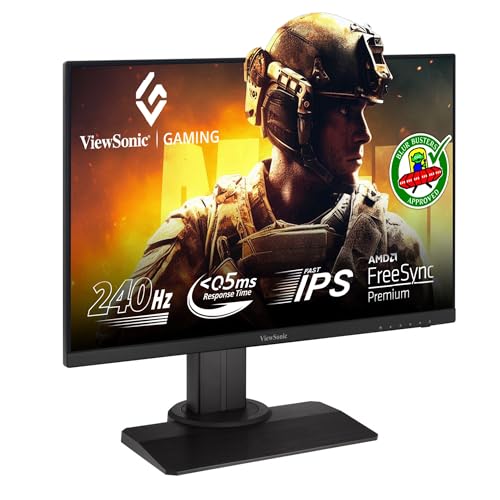
True Score
84846Experts
90986Customers
Absolutely Fresh
 SAVE $20$279.99$259.99
SAVE $20$279.99$259.99Read More
Snapshot
Reasons to Buy
- Better-than-average response time
- Low input lag
- 240Hz native refresh rate
- Good viewing angles
Reasons to Avoid
- Sub-par image quality
Specifications

Aspect Ratio 16:9 
Available Inputs 3.5mm, DisplayPort, HDMI, USB 
Bluelight Filter Yes 
Built-In Speakers Yes 
Built-In Webcam No 
Curved Screen No Display Type LCD 
Flicker Free Yes HDMI Inputs 2 HDR Format HDR10, HDR400 High Dynamic Range (HDR) Yes Max Resolution 1920 x 1080 (Full HD) 
Panel Type IPS Refresh Rate 240 Hz 
Response Time 1 ms 
Rotating Screen Yes Screen size 23.8″ 
Sync Technology AMD FreeSync Premium All Specs
Test Results
Brightness (nits) 354 Contrast Ratio (as ratio, x:1) 823 Color Gamut/Accuracy % (DCI P3 xy) 74 Color Gamut/Accuracy % (DCI P3 uv) 0 Color Gamut % (Adobe RGB Coverage xy) 76 Color Gamut % (sRGB Coverage xy) 101 All Retailers
- $259.99$280Save $20
Availability
Free Shipping
Yes - $279.99
Availability
In StockFree Shipping
Yes - $279.99$365Save $85
Availability
In StockFree Shipping
No
Our Verdict
If you work in a bright room or have a lot of ambient light, the Viewsonic XG2431, with its great brightness of 354.195 nits, is the one for you. This feature, combined with a blue light filter and flicker-free technology, helps this monitor minimize eye fatigue. It features an okay contrast ratio of 822.65:1, but it’s on the lower side, affecting the depth and richness of visuals, though it may suffice for general use.
It offers a lower DCI-P3 coverage of 73.50%, meaning it can still provide a wide range of colors, delivering vibrant visuals suitable for general use, but it may not be suited for color-critical tasks. It has a 4.9% reflectance rate, which can handle ambient light well, ensuring decent screen visibility and comfort for users in various lighting conditions. It’s priced significantly lower than the Asus ROG PG27AQDM, making it a great value considering its high refresh rate of 240 Hz and HDR10 support, which enhances the visual experience with better contrast and color depth.
The Viewsonic XG2431 has a higher brightness level than the HP OMEN 27QS, enhancing your visual experience. However, it has a slightly higher input lag at 16.9 ms and a slower response time of 5.0 ms. This can affect fast-paced activities but is still acceptable for most users.
With its high brightness and features that combat eye fatigue, it’s ideal for bright environments and offers value at a lower price point. While the compromise is mainly its slower response time and modest DCI-P3 color coverage, they are minor for most users. Its ergonomic design and performance make it a versatile and appealing choice for a wide range of applications.
Read Less

Best Overall

Runner Up

Best Value

Best Budget

Best Mid-Range

Premium Pick
Corsair Xeneon 27QHD240
Best For Macbook Pro
The Corsair Xeneon 27QHD240 has a great response time, contrast ratio, and reflectance rate, minimizing glare and maximizing vibrance and smoothness for color-critical work, gaming and video playback.
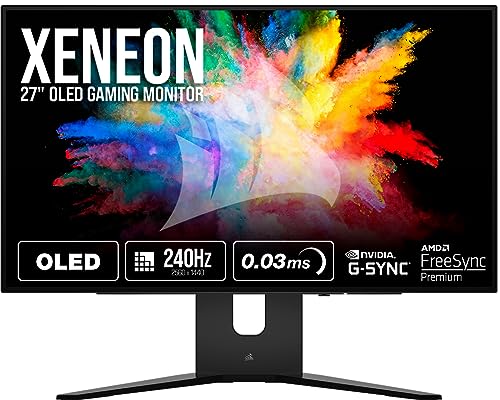
True Score
848310Experts
90336Customers
Absolutely Fresh
 $999.99
$999.99Read More
Snapshot
Reasons to Buy
- Excellent OLED Picture Quality
- Ultra-Fast Response Time
- Low Input Lag
- High Refresh Rate and VRR Support
Reasons to Avoid
- Lower Peak Brightness Levels
- Higher Input Lag with Different Refresh Rates
- Potential OLED Burn-In
Specifications

Available Inputs 3.5mm, DisplayPort, HDMI, USB 
Bluelight Filter Yes 
Built-In Speakers No 
Built-In Webcam No 
Curved Screen No Display Type OLED 
Flicker Free Yes HDMI Inputs 2 HDR Format HDR10 High Dynamic Range (HDR) Yes Max Resolution 2560 x 1440 
Panel Type OLED Refresh Rate 240 Hz 
Response Time 0.03 ms 
Rotating Screen Yes Screen size 27″ 
Sync Technology AMD FreeSync, G-Sync All Specs
Test Results
Brightness (nits) 318 Contrast Ratio (as ratio, x:1) 9,473 Color Gamut/Accuracy % (DCI P3 xy) 96 Color Gamut/Accuracy % (DCI P3 uv) 0 Color Gamut % (Adobe RGB Coverage xy) 90 Color Gamut % (sRGB Coverage xy) 107 All Retailers
- $999.99
Availability
In StockFree Shipping
Yes - $999.99
Availability
Free Shipping
Yes - $1,103.65
Availability
In StockFree Shipping
No
Our Verdict
If crisp and blur-free content with minimal glare matters most to you, then the Corsair Xeneon 27QHD240, with the best-in-class response time of 0.79 ms, is an excellent solution. Along with a high refresh rate of 240 Hz, it makes it a superb choice for gaming and video playback, where quick screen transitions are required. Its input lag of 13.6 ms is generally considered good for most users and applications, including casual gaming and multimedia consumption. With an unmatched reflectance rate of 1.8%, this monitor significantly reduces glare and reflections, enhancing visibility and eye comfort in brightly lit environments.
The OLED monitor has a best-in-class contrast ratio of 9,473:1, meaning it can display extremely deep blacks and bright whites, enhancing the overall image quality with more vivid and detailed visuals. When compared to the HP OMEN 27QS, the Corsair Xeneon 27QHD240 has a lower brightness, measuring 317.53 nits, but it significantly outperforms it with its faster response time. Its brightness is still good enough for bright indoor rooms, though probably not direct sunlight.
It boasts a best-in-class 96.10% DCI-P3 coverage, offering wide and accurate color reproduction, ideal for professionals in photography, video editing, and design who require true-to-life colors. It also includes features such as a blue light filter and flicker-free technology, which are important for reducing eye strain. It lacks built-in speakers, implying the need for external audio solutions.
If you’re willing to invest in an external audio solution, the Corsair could be an excellent choice. Despite its premium price, it offers the best anti-glare ability, response time, and high contrast, which may justify the cost if you’re a professional who needs these specific features.
Read Less

Best Overall

Runner Up

Best Value

Best Budget

Best Mid-Range

Premium Pick
Dell S2722QC
The Dell S2722QC is ideal for bright environments. It combines high brightness with a good reflection rate for clear visibility. It features a responsive input lag, sufficient refresh rate, and good response time for minimal motion blur, enhancing productivity.
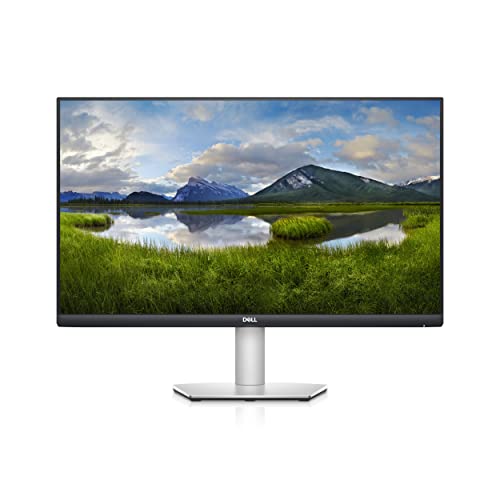
True Score
82813Experts
883kCustomers
Absolutely Fresh
 SAVE $120$369.99$249.99
SAVE $120$369.99$249.99Read More
Snapshot
Reasons to Buy
- 4K screen resolution delivers high picture quality
- Supports Variable Refresh Rate technology
- Thin top and side frame for multi-monitor setup
- Great ergonomics
- Wide viewing angles
Reasons to Avoid
- Low 60Hz refresh rate
- No HDMI 2.1 ports
- Low contrast ratio
Specifications

Available Inputs 3.5mm, HDMI, USB 
Bluelight Filter Yes 
Built-In Speakers Yes 
Built-In Webcam No 
Curved Screen No Display Type IPS 
Flicker Free Yes HDMI Inputs 2 HDR Format HDR10 High Dynamic Range (HDR) Yes Max Resolution 3840 x 2160 (4k) 
Panel Type IPS Refresh Rate 60 Hz 
Response Time 4 ms 
Rotating Screen Yes Screen size 27″ 
Sync Technology AMD FreeSync, G-Sync All Specs
Test Results
Brightness (nits) 339 Contrast Ratio (as ratio, x:1) 1,247 Color Gamut/Accuracy % (DCI P3 xy) 83 Color Gamut/Accuracy % (DCI P3 uv) 0 Color Gamut % (Adobe RGB Coverage xy) 79 Color Gamut % (sRGB Coverage xy) 100 All Retailers
- $249.99$370Save $120
Availability
In StockFree Shipping
Yes - $319.99
Availability
In StockFree Shipping
Yes - $323.86$558Save $234
Availability
In StockFree Shipping
No
Our Verdict
If you work in a brightly lit environment, the Dell S2722QC is a great pick to consider. With a brightness of 339 nits, it ensures clear visibility under various lighting conditions. It’s suitable for well-lit environments without causing excessive glare, thanks to a relatively low total reflection percentage of 4.6%.
Its input lag of 9 ms makes it a highly responsive monitor, beneficial for tasks that require quick feedback from inputs. Its refresh rate of 60 Hz is sufficient for most productivity tasks and casual gaming, ensuring a smooth and strain-free experience. Its response time of 8.3 ms minimizes motion blur, providing a more comfortable viewing experience during dynamic content viewing, making it ideal for productivity.
The 4K resolution and HDR10 support offer sharp, detailed images and a wide range of colors for an enjoyable viewing experience. It’s very similar to the Dell G2724D, and while the G2724D has a higher brightness, the S2722QC has a higher resolution for crisp, detailed visuals. Its contrast ratio of 1247:1 offers a good balance between bright and dark areas, ensuring a crisp image quality that is easy on the eyes. Its 82.90% DCI-P3 coverage provides a wide and fairly accurate color range, making it suitable for enjoying rich and vibrant visuals in general viewing scenarios. It’s equipped with a blue light filter and flicker-free technology, which are essential for reducing eye strain during prolonged use.
With its impressive brightness level, responsive input lag, and decent response time, this monitor is designed to deliver a comfortable and enjoyable viewing experience during work or play. However, its refresh rate may not meet the needs of hardcore gamers, marking a slight compromise for this otherwise stellar monitor.
Read Less

Best Overall

Runner Up

Best Value

Best Budget

Best Mid-Range

Premium Pick
Dell G2724D
The Dell G2724D has a top-tier brightness, blue light filter, and flicker-free technology for eye comfort. With good contrast, manageable reflectance, and wide color coverage, it balances performance and cost-effectively.
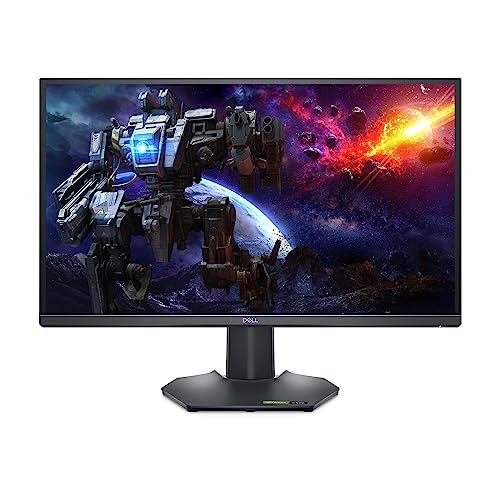
True Score
82822Experts
88126Customers
Absolutely Fresh
 $288.00
$288.00Read More
Snapshot
Reasons to Buy
- Great image quality
- Low Input lag
- High native refresh rate
Reasons to Avoid
- Subpar contrast ratio and HDR color gamut
- Okay response time
- No HDMI 2.1 and USB ports
Specifications

Aspect Ratio 16:9 
Available Inputs DisplayPort, HDMI 
Bluelight Filter Yes 
Built-In Speakers No 
Built-In Webcam No 
Curved Screen No Display Type LED 
Flicker Free Yes HDMI Inputs 2 HDR Format HDR10, HDR400 High Dynamic Range (HDR) Yes Max Resolution 2560 x 1440 
Panel Type IPS Refresh Rate 165 Hz 
Response Time 1 ms 
Rotating Screen Yes Screen size 27″ 
Sync Technology AMD FreeSync Premium, G-Sync, VESA Adaptive-Sync All Specs
Test Results
Brightness (nits) 432 Contrast Ratio (as ratio, x:1) 1,350 Color Gamut/Accuracy % (DCI P3 xy) 86 Color Gamut/Accuracy % (DCI P3 uv) 0 Color Gamut % (Adobe RGB Coverage xy) 82 Color Gamut % (sRGB Coverage xy) 100 All Retailers
- $288.00
Availability
In StockFree Shipping
No
Our Verdict
If you need to set up your monitor in a bright room or have a ton of ambient light to deal with, the Dell G2724D, with its best-in-class brightness of 432.0 nits, is a superb choice. This monitor ensures clear and vivid visuals even in brightly lit environments. It’s also equipped with a blue light filter and flicker-free technology, prioritizing your eye comfort during extended use. It boasts a contrast ratio of 1350:1, which is quite good for an IPS panel, contributing to better image quality and clarity.
When compared to the Corsair Xeneon 27QHD240, the Dell G2724D offers a higher brightness but has a slightly higher response time of 4.3 ms. This difference may be noticeable in very fast-paced content, but for most users, this response time ensures minimal motion blur during movies and casual gaming. In terms of input lag, it has a low 9.0 ms, which is great for a responsive user experience. The refresh rate of 165 Hz is suitable for most users, especially if you’re a casual gamer.
Its 4.8% reflectance rate effectively balances screen visibility and comfort, managing ambient light reflections well enough for most indoor environments. A monitor with 86.40% DCI-P3 coverage provides a broad spectrum of colors, offering color reproduction suitable for general media consumption.
This monitor provides a balance between performance and cost. If a bright display is your top priority and you’re on a budget, then with its solid performance, this monitor is an excellent choice to consider. It doesn’t have the deepest blacks, brightest whites, and most vibrant colors, but it’s still adequate for everyday tasks in bright rooms without breaking the bank.
Read Less
Which Criteria Matters for Testing Best Monitor for Eye Strain?
By focusing on these criteria (2 required), anyone can quickly and easily compare these computer monitors and how they’ll perform. This helps you make an informed decision and purchase the best monitor for your eyes.
| CRITERIA | RANGE | REQUIRED | DEFINITION |
|---|---|---|---|
| Reflections | < 5% | Yes | The total amount of light, in percentage, your monitor reflects. |
| Brightness | > 300 nits | Yes | How bright the monitor will get, usually under specific testing conditions, like 10% windows (which means 10% of the screen is a white box.) |
Our Trusted Data Sources
We looked at 110+ computer monitor reviewers and found that 33 are trustworthy (60%+ Trust Rating). The three we have listed below are our most trusted for computer monitors.
- Samuel Breton – Rtings, MuckRack
- Chris Eberle – Tom’s Hardware, LinkedIn
- Tony Hoffman – PC Mag, MuckRack
Interested in a comprehensive analysis of our data sources? We’ve got you covered. Below, you’ll find a detailed list of every computer monitor review website we’ve identified, organized by their respective Trust Ratings from highest to lowest. But we didn’t stop there. We’ve meticulously reviewed each publication and verified the data by checking whether the authors have bio links to MuckRack or LinkedIn. We’re committed to not only checking the facts but ensuring their veracity.
Computer Monitor Test Data & Results
1. Brightness (Nits) Test Results
Brightness is the biggest determining factor for how vivid images appear and how well a monitor is going to deal with the environment it’s placed in. Brightly lit offices will make it harder to see the screen if the brightness is too low, which degrades the image quality of anything on screen.
In most situations, we recommend a brightness of at least 200 nits, though higher is always better, as it allows the monitor to be placed in progressively brighter rooms and offices without issue. That said, 300 nits are enough to work in standard lighting conditions so that images stay vivid.
Brightness
> 300 nits
Acceptable range of performance
Definition: The difference in brightness between the whites (lit sections) and blacks (dim or unlit sections) of a monitor panel.
Units of Measurement: Nits
Tools to Measure: Luminance meter or photometer or colorimeter
Why It’s Important:
Brightness is how a monitor is able to display vivid images and overcome ambient light sources.
Brightness (in nits; higher is better)
2. Reflections % (Total Reflections) Test Results
Reflections % (Total Reflections)
< 5%
Acceptable range of performance
Definition: How much light is reflected by the screen from ambient and direct light sources.
Units of Measurement: %
Tools to Measure: Camera
Why It’s Important:
Reflections and glare ruin the image quality on screen by washing out the image itself and making it hard to see what you’re doing.
When using a monitor in any kind of room outside of one that’s pitch black, the screen is going to reflect light. As the light becomes strong, you’re likely to see more light and more glare reflect off it, but depending on the coating and screen type, this can be mitigated. Good screen coatings will keep ambient light and direct light managed by reducing the impact they have on the screen. Bad reflections handling means even weak light sources will create glare that makes it hard to use the monitor.
That’s why we recommend your monitor reflect no more than 6% of the total light shining on it. This keeps glare in check, prevents image quality from being ruined, and allows you to actually see what you’re working on when using your monitor. Lower is always better, but 5% is enough to work without issue.
Reflections % (lower is better)
Best Monitor for Eye Strain: Mistakes To Avoid
- Ignoring Flicker-Free Technology: Flickering screens can cause eye strain and headaches. Opt for monitors with flicker-free technology to minimize this issue.
- Choosing the Wrong Screen Size and Resolution: A monitor that’s too small or with a low resolution can cause you to squint and strain your eyes. On the other hand, a screen that’s too large or with a high resolution might force you to strain to see smaller text. Find a balance that suits your needs. If you are an aspiring competitive gamer, consider what size monitor pro gamers use for optimal field of view and responsiveness. For superior image quality and detailed graphics, the best 4K monitor provides a high resolution that enhances work and play.
- Overlooking Adjustable Brightness and Contrast: A monitor with adjustable brightness and contrast allows you to customize the display to your comfort level and the surrounding lighting conditions. To further reduce eye strain and enhance viewing comfort, employing the best monitor settings for your eyes is crucial.
- Ignoring Ergonomic Features: Consider monitors that offer ergonomic features such as height adjustment, tilt, and swivel options. Proper ergonomics can reduce neck and eye strain by allowing you to position the monitor at a comfortable viewing angle. The best computer monitors for work include ergonomic adjustments and offer optimal screen size and resolution to enhance productivity and minimize fatigue.
ADDITIONAL Monitor TIPS
To further reduce eye strain, you might find our tips on reducing monitor glare quite useful. Understanding the differences between LCD and LED monitors for eye health can also help you make a more informed decision. Get insights into understanding nits of brightness and the unique characteristics of a CRT monitor. If you’re wondering about performance, explore whether a monitor affects gaming and how to choose the right size with our 24 vs 27-inch monitor comparison.
Maintaining your monitor is crucial, so learn how to clean your monitor without streaks. Adjusting settings can also play a significant role in comfort; find out how to change brightness on Windows 10. Lastly, consider whether a monitor warranty is worth it to protect your investment.
The Best Monitor for Eye Strain Tests Compared
Product |
True Score
|
Brightness
|
Contrast Ratio
|
Color Gamut (DCI P3)
|
Color Gamut (sRGB)
|
Input Lag (ms)
|
Response Time (ms)
|
Reflections % | |
|---|---|---|---|---|---|---|---|---|---|
| 87 |
|
|
|
|
|
|
| $741.00 |
| 85 |
|
|
|
|
|
|
| $219.99 $340 $120 |
84 |
|
|
|
|
|
|
| $259.99 $280 $20 | |
| 84 |
|
|
|
|
|
|
| $999.99 |
| 82 |
|
|
|
|
|
|
| $249.99 $370 $120 |
| 82 |
|
|
|
|
|
|
| $288.00 |

